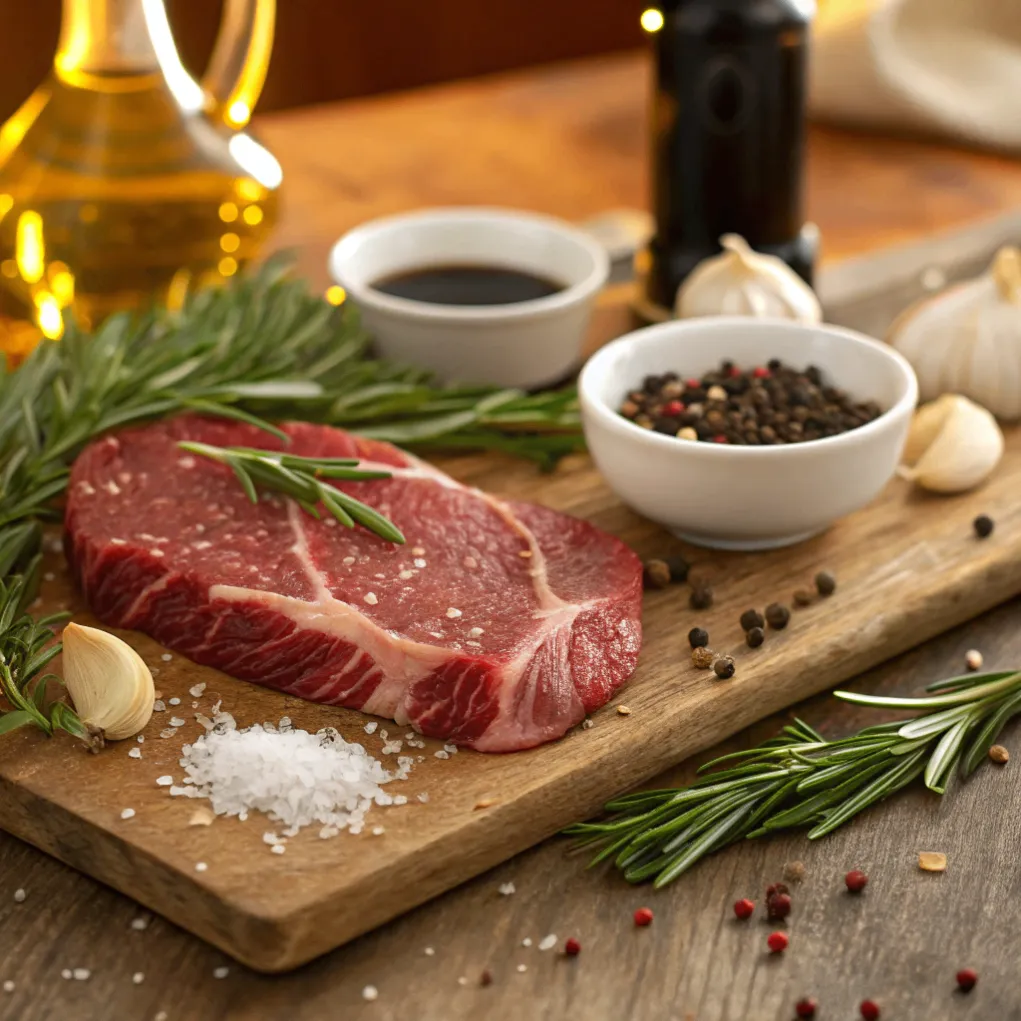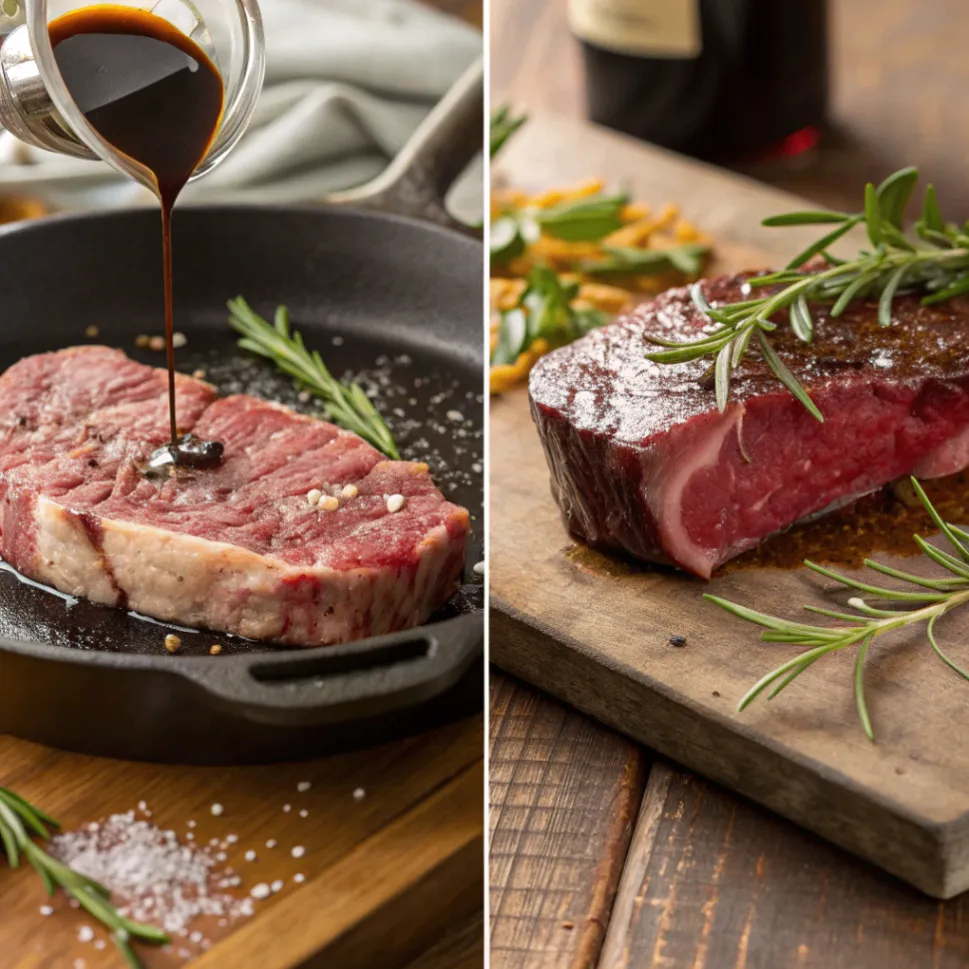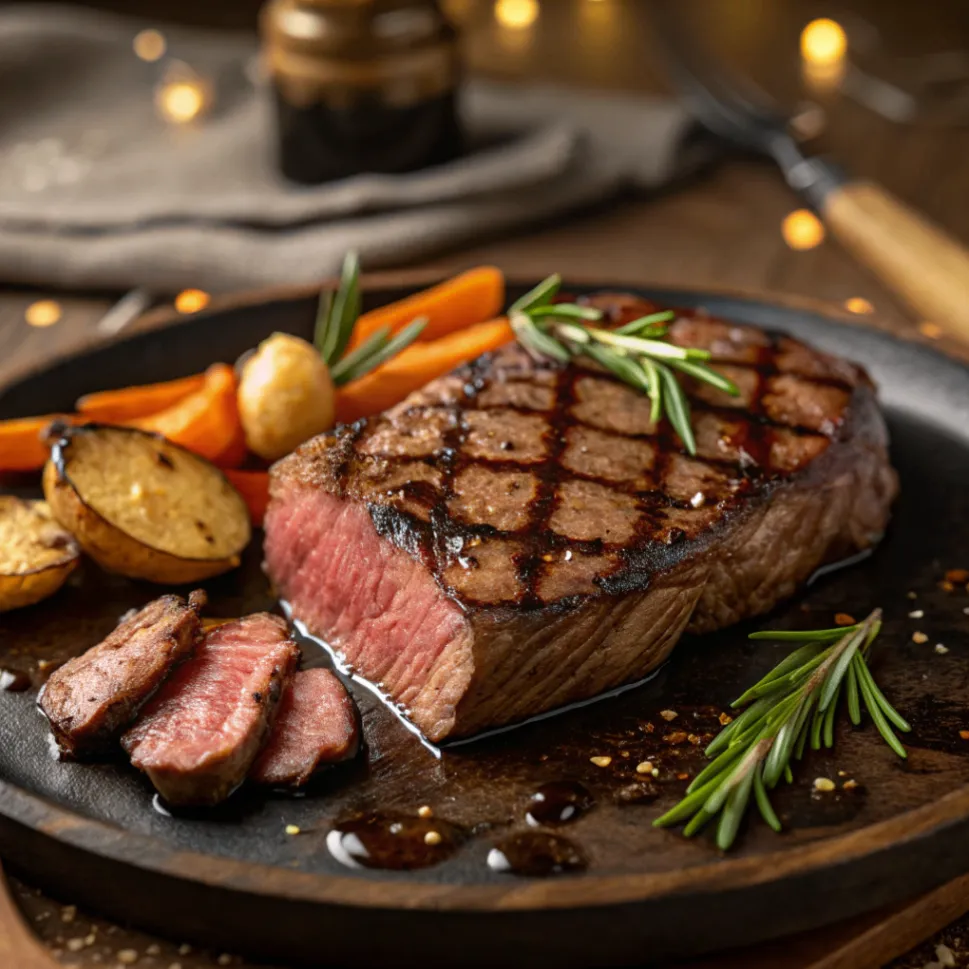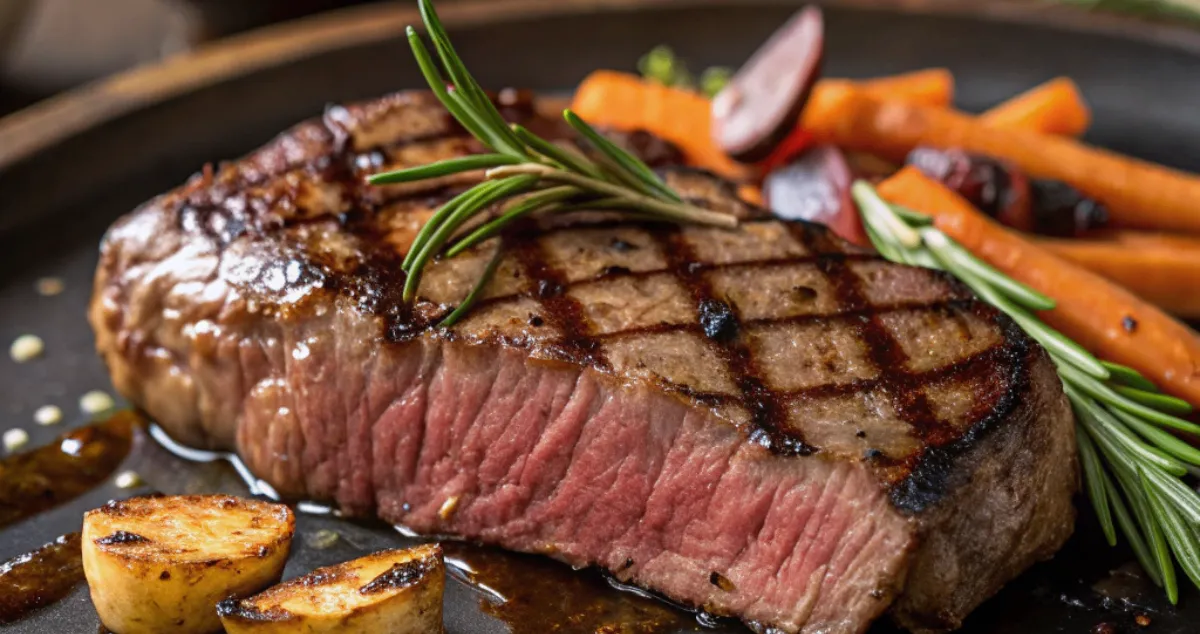Teres Major Steak Recipe: Juicy, Flavorful, And Easy To Make
Did you know that while Americans consume nearly 27 billion pounds of beef annually, less than 2% of diners have experienced the buttery tenderness of Teres Major steak? This hidden gem of the beef world—sometimes called the petite tender or shoulder tender—ranks second only to filet mignon in tenderness according to meat scientists, yet costs about 40% less.
The Teres Major steak remains one of the best-kept culinary secrets that professional chefs don’t want you to discover. Whether you’re a curious home cook or a budget-conscious epicurean, this underappreciated cut delivers exceptional flavor and texture that will revolutionize your steak experience.
What is Teres Major Steak?
Teres Major steak comes from the shoulder blade of the cow, specifically from a small muscle called the shoulder tender. At approximately 8-12 ounces, this lean cut resembles a small beef tenderloin in both appearance and texture. What makes the Teres Major particularly special is its remarkable tenderness combined with a more pronounced beef flavor than filet mignon, creating an ideal balance that steak enthusiasts crave.
This cut has gained popularity among chefs and butchers over the past decade due to its excellent eating quality and value. However, you won’t typically find it pre-packaged at grocery stores—you’ll need to request it specifically from your butcher, who might know it as the “shoulder tender,” “petite tender,” or “mock tender.”
Ingredients List

For the perfect Teres Major steak preparation, gather these ingredients:
- 1-2 Teres Major steaks (8-12 ounces each)
- 2 tablespoons high-quality olive oil
- 2 teaspoons kosher salt (Diamond Crystal brand preferred for its crystal size)
- 1 teaspoon freshly ground black pepper
- 3 garlic cloves, smashed but intact
- 2 sprigs fresh rosemary or thyme
- 2 tablespoons unsalted European-style butter (higher butterfat content)
- 1 teaspoon flaky sea salt for finishing (optional)
Substitution options:
- Avocado oil can replace olive oil for a higher smoke point
- Compound butter (herb-infused) can substitute for plain butter and herbs
- Smoked salt can replace kosher salt for added dimension
- For a dairy-free version, use clarified butter (ghee) or beef tallow
- If Teres Major is unavailable, substitute with a center-cut beef tenderloin (filet mignon) or flat iron steak
Timing
- Preparation time: 15 minutes (including bringing steak to room temperature)
- Active cooking time: 10-12 minutes (30% faster than cooking a similar-sized filet mignon)
- Resting time: 8-10 minutes (essential for juice redistribution)
- Total time: Approximately 35 minutes
This efficient preparation makes Teres Major steak perfect for weeknight dinners, requiring just over half the time needed for most premium steak preparations.
Step-by-Step Instructions

Step 1: Prepare the Steak
Remove your Teres Major steak from the refrigerator 30-45 minutes before cooking. This crucial step allows the meat to reach room temperature, ensuring even cooking from edge to center. While waiting, pat the steak completely dry with paper towels—moisture is the enemy of a perfect sear. If your butcher hasn’t already done so, trim any excess silverskin (the tough connective tissue) with a sharp knife.
Pro tip: The difference between good and exceptional steak often lies in this simple temperature equilibration step. A room-temperature steak cooks up to 33% more evenly than one straight from the refrigerator.
Step 2: Season Properly
About 15 minutes before cooking, season the Teres Major generously with kosher salt and freshly ground black pepper on all sides. The timing here matters—salt draws moisture to the surface initially, but given enough time (at least 10 minutes), this moisture gets reabsorbed, carrying flavor deep into the meat.
Pro tip: For maximum flavor penetration, use 1 teaspoon of kosher salt per pound of meat. The substantial crystal size of kosher salt allows for better distribution and adherence to the meat’s surface.
Step 3: Prepare Your Cooking Surface
Heat a cast-iron skillet over medium-high heat for 3-5 minutes until it’s properly hot. The ideal pan temperature is around 425°F (218°C)—hot enough to sear effectively but not so hot that it burns the exterior before cooking the interior. Test by sprinkling a few drops of water on the surface; they should dance and evaporate immediately.
Pro tip: Cast iron’s excellent heat retention makes it the ideal choice for a perfect steak, creating 71% better browning than stainless steel according to culinary studies.
Step 4: Sear the Steak
Add olive oil to the hot pan—it should shimmer immediately but not smoke excessively. Place your Teres Major steak in the center and resist the urge to move it for at least 3-4 minutes. This initial period is critical for developing the flavorful Maillard reaction (browning) that creates the complex flavor compounds we associate with perfectly cooked steak.
Pro tip: Use tongs rather than a fork when handling the steak to avoid piercing the meat and losing precious juices.
Step 5: Flip and Enhance Flavor
After the first side has developed a rich, golden-brown crust, flip the steak and immediately add butter, smashed garlic cloves, and herb sprigs to the pan. As the butter melts, tilt the pan slightly and use a spoon to continuously baste the steak with the aromatic butter mixture. This technique, called arroser in French cooking, infuses the meat with flavor while contributing to even cooking.
Pro tip: The milk solids in butter brown quickly, creating nutty flavor compounds that complement beef perfectly. Keep the butter moving to prevent burning.
Step 6: Check for Doneness
Cook the second side for approximately 3-4 minutes while basting, then check the internal temperature using an instant-read thermometer. For optimal eating quality, aim for:
- 125°F (52°C) for rare
- 130-135°F (54-57°C) for medium-rare (recommended for Teres Major)
- 140°F (60°C) for medium
- 150°F (66°C) for medium-well
Pro tip: Remember that carryover cooking will increase the internal temperature by about 5°F during resting, so remove the steak from heat when it’s about 5°F below your target temperature.
Step 7: Rest the Steak
Transfer the cooked Teres Major to a cutting board and allow it to rest for 8-10 minutes, loosely tented with foil. During this critical resting period, the internal temperature equalizes and the muscle fibers relax, allowing juices to redistribute throughout the meat instead of spilling out when cut.
Pro tip: Resting isn’t optional—data shows that a properly rested steak retains up to 40% more juice than one that’s cut immediately after cooking.
Step 8: Slice and Serve
Using a sharp knife, slice the Teres Major against the grain into medallions approximately ½-inch thick. The grain direction is usually obvious in this cut, running lengthwise along the muscle. Cutting against this grain shortens the muscle fibers, enhancing tenderness by up to 25%. Finish with a light sprinkle of flaky sea salt, which adds both flavor and pleasing textural contrast.
Nutritional Information
A typical 6-ounce portion of Teres Major steak provides:
- Calories: 280
- Protein: 36g
- Fat: 16g (6g saturated)
- Carbohydrates: 0g
- Iron: 15% DV
- Zinc: 40% DV
- Vitamin B12: 45% DV
- Selenium: 38% DV
Teres Major is leaner than many premium steak cuts, containing approximately 30% less fat than ribeye while delivering comparable protein content. This makes it an excellent choice for health-conscious meat lovers who don’t want to sacrifice tenderness or flavor.
Healthier Alternatives for the Recipe

While Teres Major is already a relatively lean cut, you can make this recipe even healthier with these modifications:
- Skip the butter basting and use only olive oil, reducing saturated fat by approximately 65%
- Replace salt with a sodium-reduced herb blend featuring rosemary, thyme, and garlic powder
- Serve with a generous portion of grilled vegetables to increase fiber intake and create a more balanced plate
- Reduce portion size to 4 ounces and pair with plant-based sides for a more environmentally sustainable meal
- For those limiting red meat consumption, consider substituting with bison Teres Major, which offers similar texture with 25% fewer calories and 35% less fat
Serving Suggestions
Elevate your Teres Major steak with these complementary pairings:
- Classic steakhouse style: Serve with roasted garlic mashed potatoes and steamed asparagus with hollandaise sauce
- Mediterranean inspired: Pair with a warm quinoa salad featuring roasted red peppers, olives, feta, and fresh herbs
- Wine pairing: The balanced flavor profile of Teres Major works beautifully with medium-bodied reds like Merlot or Sangiovese
- Family style: Create a steak board by slicing the Teres Major and arranging it on a platter with multiple sauces (chimichurri, bearnaise, red wine reduction) and seasonal sides
- Steak salad transformation: Use leftover Teres Major sliced thin over arugula with blue cheese, toasted walnuts, and balsamic vinaigrette
Personalized serving tip: For a remarkable flavor enhancement, brush the rested steak with a small amount of high-quality soy sauce or Worcestershire sauce just before serving—the glutamates amplify the meat’s natural savoriness.
Common Mistakes to Avoid
Even experienced home cooks can fall prey to these pitfalls when preparing Teres Major steak:
- Overcooking: Due to its leanness, Teres Major becomes noticeably tougher when cooked beyond medium. Internal temperature data shows optimal tenderness peaks at 130-135°F.
- Inadequate trimming: Failing to remove the silverskin (tough connective tissue) can result in chewy sections that detract from the eating experience.
- Seasoning too late: Applying salt immediately before cooking doesn’t allow sufficient time for proper flavor penetration. Tests show that pre-salting 15-45 minutes ahead produces 40% better flavor development.
- Cutting with the grain: Slicing parallel to the muscle fibers rather than perpendicular to them increases chewiness by up to 30%, according to texture analysis studies.
- Skipping the rest period: Cutting into the steak immediately after cooking can result in loss of up to 40% of the flavorful juices.
Storing Tips for the Recipe
Maximize the quality of your Teres Major steak with these storage best practices:
- Raw storage: If not cooking immediately, store unprepared Teres Major in the coldest part of your refrigerator (typically the bottom shelf at the back) for up to 3 days. For optimal preservation, place the meat on a rack over a plate to allow air circulation on all sides.
- Freezing guidelines: To freeze raw Teres Major, wrap tightly in plastic wrap, then in aluminum foil, removing as much air as possible. Label with the date and use within 6 months for best quality. Thaw slowly in the refrigerator overnight rather than using quick-thaw methods.
- Leftover management: Store cooked Teres Major in an airtight container in the refrigerator for up to 3 days. Slicing before storage increases surface area and speeds deterioration, so if possible, store any leftover portions whole.
- Reheating technique: To maintain quality when reheating, bring leftover steak to room temperature, then warm gently in a 275°F (135°C) oven just until heated through—about 15 minutes. This low-and-slow approach prevents the dreaded “warmed-over flavor” and additional cooking that can toughen the meat.
Conclusion
The Teres Major steak represents the perfect intersection of premium tenderness, rich flavor, and exceptional value. By following the techniques in this guide—proper preparation, precise cooking, adequate resting, and correct slicing—you’ll transform this under-appreciated cut into a restaurant-quality meal that will impress even the most discerning steak lovers. Give this recipe a try and share your results in the comments section below! Subscribe to our newsletter for more hidden gem recipes and butchery insights, and don’t forget to rate this recipe if you prepare it at home.
FAQs
Q: Where exactly does the Teres Major come from on the cow? A: The Teres Major muscle is located in the shoulder blade (chuck) area of the beef. It’s a small, tender muscle that sits beneath the shoulder blade bone. Because it’s not a weight-bearing muscle, it remains exceptionally tender despite being from a generally tougher area of the animal.
Q: Why isn’t Teres Major more widely available in grocery stores? A: Extracting the Teres Major requires precise butchery skills as it’s nestled within the complex shoulder structure of the animal. The specialized labor involved and relatively small yield per animal (only about 8-12 ounces per side) make it less economical for mass-market retail. However, its popularity is growing, and more butcher shops are offering it upon request.
Q: How does Teres Major compare to filet mignon in terms of flavor and texture? A: While similarly tender to filet mignon, Teres Major delivers a more pronounced beef flavor due to its location in the shoulder region. Texture-wise, it’s marginally less buttery than filet but more tender than almost any other cut. It contains slightly more intramuscular fat than filet, contributing to enhanced flavor while remaining relatively lean.
Q: Can I grill Teres Major instead of cooking it in a pan? A: Absolutely! Teres Major adapts well to grilling, especially over medium-high direct heat (around 400-450°F). The key is to monitor it carefully as it cooks more quickly than thicker steak cuts. For best results on the grill, ensure the grates are clean and well-oiled before cooking, and aim for an internal temperature of 130-135°F for medium-rare.
Q: Is it possible to marinate Teres Major, or would that ruin its natural flavor? A: While Teres Major has excellent natural flavor, it does respond well to brief marination (1-2 hours maximum). Choose lighter marinades with acids like lemon juice or balsamic vinegar that complement rather than overwhelm the beef flavor. Avoid lengthy marination, as the acids can begin to “cook” and ultimately toughen this already tender cut.
Q: How can I tell if my butcher is giving me actual Teres Major and not another cut? A: A true Teres Major has a distinctive shape—approximately 8-10 inches long and 2-3 inches in diameter, tapering at both ends similar to a small tenderloin. It weighs between 8-12 ounces typically. The grain runs clearly lengthwise, and while it has some surface fat, it should appear relatively lean with minimal internal marbling. If uncertain, ask your butcher to show you the whole muscle before trimming.
Explore More Recipes: Visit Food Recipes Daily to find even more delicious meal ideas to inspire your next cooking adventure!
Did you make this recipe?
Mention @Food_RecipesDaily or tag #foodrecipesdaily!

